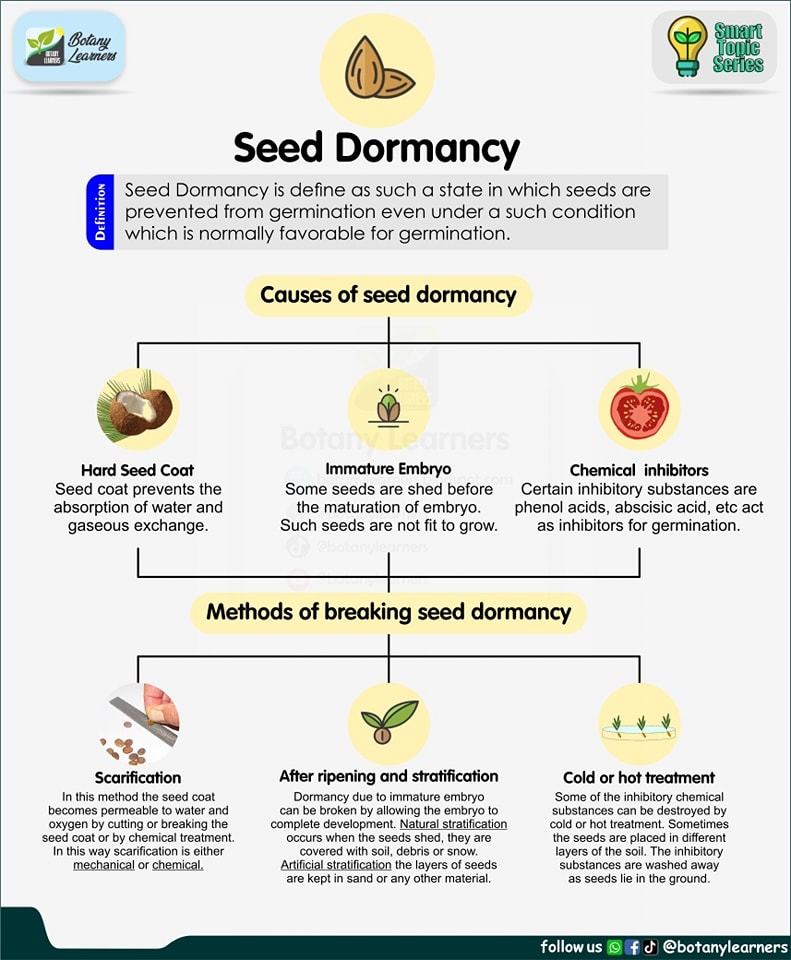Seed dormancy is a complex and adaptive strategy employed by plants to ensure the survival and germination of seeds under favorable conditions. This detailed article explores seed dormancy comprehensively, shedding light on its causes, mechanisms, and ecological and agricultural significance.
What is Seed Dormancy?
Seed dormancy is the state in which a seed remains inactive
or fails to germinate even when environmental conditions (moisture,
temperature, and oxygen) appear favorable. This inactivity is often regulated
by the seed’s internal mechanisms or external environmental triggers.
Purpose of Seed Dormancy:
- Prevents
premature germination during adverse conditions (e.g., frost, drought).
- Synchronizes
germination with seasonal changes, ensuring better survival rates.
- Enhances dispersal opportunities by spreading germination over time and space.
Types of Seed Dormancy
A. Innate Dormancy
- Present
in seeds at the time of dispersal.
- Often
results from genetic programming during seed development.
- Prevents
germination until specific environmental cues are met.
Examples: Many wild species like wheat and barley
exhibit innate dormancy.
B. Induced Dormancy
- Acquired
by seeds after dispersal due to exposure to adverse environmental
conditions, such as insufficient oxygen or extreme temperatures.
- This
dormancy is reversible when conditions improve.
Examples: Seeds buried in waterlogged or compacted
soils.
C. Enforced Dormancy
- Occurs
when external conditions, such as the absence of light or water, restrict
germination.
- Once
the restricting factor is removed, germination resumes.
Examples: Seeds in deserts remain dormant until rain
occurs.
Causes of Seed Dormancy
A. Endogenous Factors (Internal Causes):
- Hard
Seed Coat (Physical Dormancy):
- A
tough, impermeable outer layer prevents the uptake of water and gases.
- Scarification
or natural abrasion weakens the coat, allowing germination.
Examples: Legumes like peas and beans. - Immature
Embryo (Morphological Dormancy):
- Seeds
are dispersed before their embryos fully develop.
- Dormancy
breaks after the embryo matures within the seed.
Examples: Orchids and ginkgo. - Chemical
Inhibitors (Physiological Dormancy):
- Hormones
like abscisic acid (ABA) inhibit seed germination.
- Environmental
factors like light or chilling neutralize these inhibitors.
Examples: Tomato seeds. - Internal
Growth Inhibitors:
- Seeds
may lack the enzymes or growth-promoting substances needed for
germination.
B. Exogenous Factors (External Causes):
- Temperature
Extremes:
- High
temperatures or frost conditions induce dormancy.
Examples: Alpine plant seeds remain dormant until spring. - Light
Sensitivity:
- Some
seeds require exposure to specific wavelengths of light (e.g., red light)
to trigger germination.
Examples: Lettuce seeds germinate only after exposure to light. - Oxygen
Deficiency:
- Seeds
in compacted or waterlogged soils remain dormant due to low oxygen
availability.
Examples: Mangroves exhibit such dormancy.
Mechanisms of Breaking Seed Dormancy
A. Natural Methods:
Plants rely on environmental factors to overcome dormancy:
- Scarification:
- Natural
abrasion from soil particles, microbial action, or digestion by animals
weakens the seed coat.
Examples: Seeds eaten by birds pass through their digestive tract and germinate upon excretion. - Stratification:
- Exposure
to prolonged cold or warm conditions breaks dormancy.
Examples: Apple and cherry seeds require winter chilling to germinate in spring. - Fire
or Heat Exposure:
- Seeds
of fire-adapted plants germinate only after exposure to the heat or smoke
from wildfires.
Examples: Eucalyptus and certain pine species. - Water
Activation:
- Rain
or flooding softens hard seed coats and removes inhibitors, enabling
germination.
Examples: Seeds in deserts germinate after heavy rains.
B. Artificial Methods:
Humans employ techniques to break seed dormancy in
agriculture:
- Mechanical
Scarification:
- Manually
breaking or scratching the seed coat using tools or sandpaper.
- Chemical
Treatments:
- Soaking
seeds in acids (e.g., sulfuric acid) to mimic natural degradation
processes.
- Temperature
Manipulation:
- Simulating
seasonal changes in temperature to encourage germination.
Examples: Cold storage for stratification. - Hormone
Treatments:
- Application
of gibberellins or cytokinins to counteract inhibitory effects of ABA.
Importance of Seed Dormancy
A. Ecological Significance:
- Survival
in Adverse Conditions:
Dormancy ensures seeds remain viable during harsh environmental periods like droughts or frost. - Promotes
Genetic Diversity:
Seeds germinate over time, ensuring varied offspring and reducing vulnerability to pests or diseases. - Colonization
of New Habitats:
Dormant seeds can travel long distances via wind, water, or animals before germinating in new areas.
B. Agricultural Benefits:
- Seed
Storage:
Dormant seeds can be stored for years, ensuring steady crop production and food security. - Weed
Management:
Understanding weed seed dormancy helps design effective control strategies. - Synchronized
Germination:
Dormancy-breaking techniques enable uniform seedling growth in crops like rice and wheat.
Seed Dormancy and Climate Change
Climate change is altering the environmental cues that
regulate dormancy. Increasing temperatures, erratic rainfall, and changing
seasonal patterns pose challenges for plant survival. Research focuses on
understanding dormancy adaptations to develop resilient crop varieties.
Conclusion
Seed dormancy is a sophisticated strategy that enables
plants to survive and thrive in diverse environments. Its intricate mechanisms
reflect nature's adaptability and resilience. For agriculture, dormancy
presents both challenges and opportunities, offering insights into improving
crop management and conserving biodiversity. Through careful study and
application, we can harness the power of seed dormancy to ensure sustainable
agriculture and ecosystem health.






0 Comments